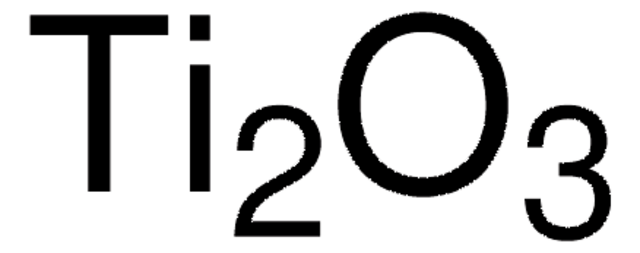Kluczowe dokumenty
204730
Titanium(IV) oxide, rutile
99.995% trace metals basis
Synonim(y):
Titanium dioxide
About This Item
Polecane produkty
Poziom jakości
Próba
99.995% trace metals basis
Formularz
powder and chunks
przydatność reakcji
reagent type: catalyst
core: titanium
gęstość
4.17 g/mL at 25 °C (lit.)
ciąg SMILES
O=[Ti]=O
InChI
1S/2O.Ti
Klucz InChI
GWEVSGVZZGPLCZ-UHFFFAOYSA-N
Szukasz podobnych produktów? Odwiedź Przewodnik dotyczący porównywania produktów
Zastosowanie
- Preparation of Visible Light Photocatalytic Graphene Embedded Rutile Titanium(IV) Oxide Composite Nanowires and Enhanced NOx Removal: This study involves the development of graphene-embedded rutile TiO2 nanocomposites for enhanced photocatalytic degradation of NOx under visible light, which is significant for environmental cleanup technologies (Lee et al., 2019).
Cechy i korzyści
Kod klasy składowania
11 - Combustible Solids
Klasa zagrożenia wodnego (WGK)
nwg
Temperatura zapłonu (°F)
Not applicable
Temperatura zapłonu (°C)
Not applicable
Środki ochrony indywidualnej
Eyeshields, Gloves, type N95 (US)
Wybierz jedną z najnowszych wersji:
Masz już ten produkt?
Dokumenty związane z niedawno zakupionymi produktami zostały zamieszczone w Bibliotece dokumentów.
Klienci oglądali również te produkty
Produkty
A Review of Mesoporous TiO2 Thin Films
The prevailing strategies for heat and electric-power production that rely on fossil and fission fuels are having a negative impact on the environment and on our living conditions.
Global Trade Item Number
| SKU | GTIN |
|---|---|
| 204730-25G | 4061838767202 |
| 204730-5G | 4061838767219 |
Nasz zespół naukowców ma doświadczenie we wszystkich obszarach badań, w tym w naukach przyrodniczych, materiałoznawstwie, syntezie chemicznej, chromatografii, analityce i wielu innych dziedzinach.
Skontaktuj się z zespołem ds. pomocy technicznej

